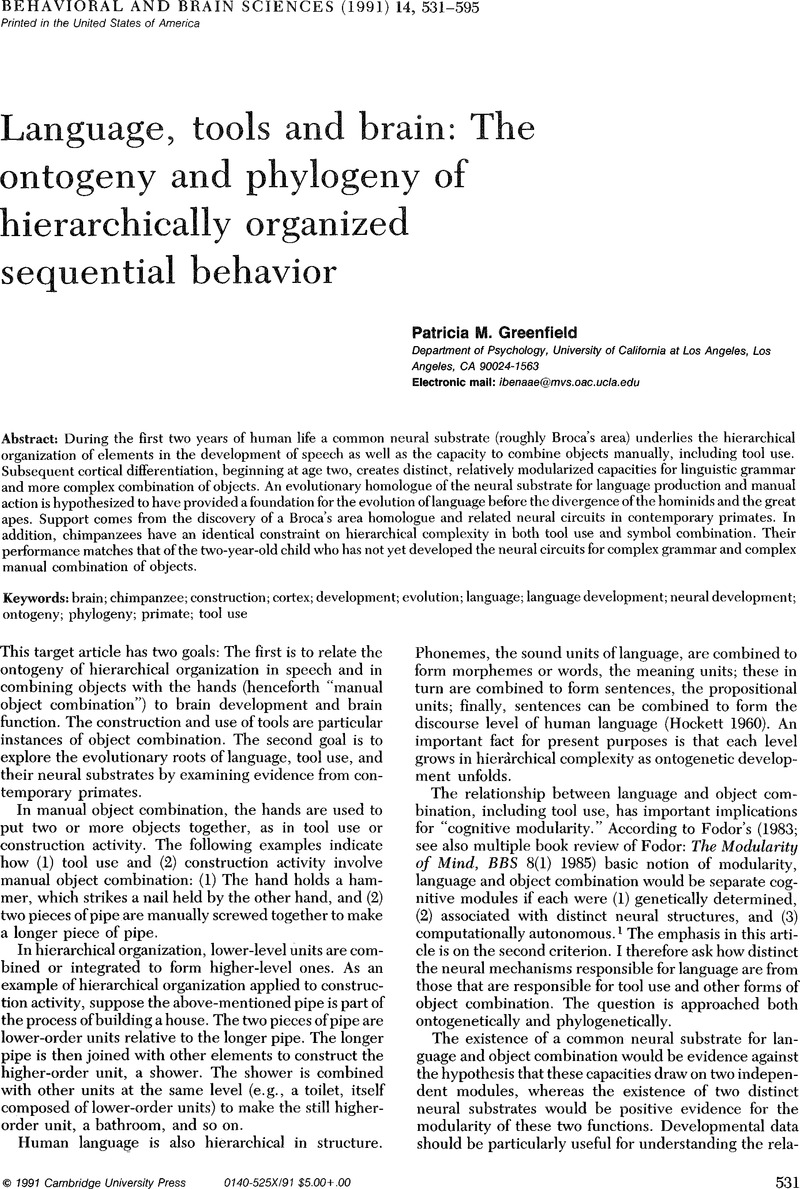Crossref Citations
This article has been cited by the following publications. This list is generated based on data provided by Crossref.
Huffman, Michael A.
and
Kalunde, Mohamedi Seifu
1993.
Tool-assisted predation on a squirrel by a female chimpanzee in the Mahale Mountains, Tanzania.
Primates,
Vol. 34,
Issue. 1,
p.
93.
Sugiyama, Yukimaru
Fushimi, Takao
Sakura, Osamu
and
Matsuzawa, Tetsuro
1993.
Hand preference and tool use in wild chimpanzees.
Primates,
Vol. 34,
Issue. 2,
p.
151.
Piñon, Denise
and
Greenfield, Patricia M.
1994.
Does everybody do it? Hierarchically organized sequential activity in robots, birds and monkeys.
Behavioral and Brain Sciences,
Vol. 17,
Issue. 2,
p.
361.
Andreae, John H.
and
Ryan, Shaun W.
1994.
Associative learning and task complexity.
Behavioral and Brain Sciences,
Vol. 17,
Issue. 2,
p.
357.
Pepperberg, Irene M.
1994.
Language and cognition: The interesting case of subjects “P”.
Behavioral and Brain Sciences,
Vol. 17,
Issue. 2,
p.
359.
Westergaard, Gregory Charles
and
Suomi, Stephen J.
1994.
Hierarchical complexity of combinatorial manipulation in capuchin monkeys (Cebus apella).
American Journal of Primatology,
Vol. 32,
Issue. 3,
p.
171.
Sugiyama, Yukimaru
1994.
Age‐specific birth rate and lifetime reproductive success of chimpanzees at Bossou, Guinea.
American Journal of Primatology,
Vol. 32,
Issue. 4,
p.
311.
Westergaard, Gregory Charles
1994.
Language, tools and neurobehavioral laterality.
Behavioral and Brain Sciences,
Vol. 17,
Issue. 2,
p.
360.
Potì, Patrizia
1996.
Spatial aspects of spontaneous object grouping by young chimpanzees(Pan troglodytes).
International Journal of Primatology,
Vol. 17,
Issue. 1,
p.
101.
McGrew, W. C.
and
Marchant, L. F.
1997.
Using the Tools at Hand: Manual Laterality and Elementary Technology in Cebus spp. and Pan spp..
International Journal of Primatology,
Vol. 18,
Issue. 5,
p.
787.
Westergaard, Gregory Charles
Wagner, Joseph L.
and
Suomi, Stephen J.
1999.
Manipulative Tendencies of Captive Cebus albifrons
.
International Journal of Primatology,
Vol. 20,
Issue. 5,
p.
751.
Bermejo, Magdalena
and
Illera, German
1999.
Tool-set for termite-fishing and honey extraction by wild chimpanzees in the Lossi Forest, Congo.
Primates,
Vol. 40,
Issue. 4,
p.
619.
Lestel, Dominique
1999.
Portrait de l'animal comme sujet.
Revue de Synthèse,
Vol. 120,
Issue. 1,
p.
139.
Lestel, Dominique
and
Grundmann, Emmanuelle
1999.
Tools, techniques and animals: the role of mediations of actions in the dynamics of social behaviours.
Social Science Information,
Vol. 38,
Issue. 3,
p.
367.
Call, Josep
2000.
Representing Space and Objects in Monkeys and Apes.
Cognitive Science,
Vol. 24,
Issue. 3,
p.
397.
Jalles-Filho, Euphly
Teixeira Da Cunha, Rogério Grassetto
and
Salm, Rodolfo Aureliano
2001.
Transport of tools and mental representation: is capuchin monkey tool behaviour a useful model of Plio-Pleistocene hominid technology?.
Journal of Human Evolution,
Vol. 40,
Issue. 5,
p.
365.
Pepperberg, Irene M.
and
Shive, Heather R.
2001.
Simultaneous development of vocal and physical object combinations by a grey parrot (Psittaus erithacus): Bottle caps, lids, and labels..
Journal of Comparative Psychology,
Vol. 115,
Issue. 4,
p.
376.
Hihara, Sayaka
Obayashi, Shigeru
Tanaka, Michio
and
Iriki, Atsushi
2003.
Rapid learning of sequential tool use by macaque monkeys.
Physiology & Behavior,
Vol. 78,
Issue. 3,
p.
427.
OKANOYA, KAZUO
2004.
Functional and structural pre‐adaptations to language: Insight from comparative cognitive science into the study of language origin1.
Japanese Psychological Research,
Vol. 46,
Issue. 3,
p.
207.
TOKIMOTO, NAOKO
and
OKANOYA, KAZUO
2004.
Spontaneous construction of “Chinese boxes” by Degus (Octodon degu): A rudiment of recursive intelligence?1.
Japanese Psychological Research,
Vol. 46,
Issue. 3,
p.
255.


